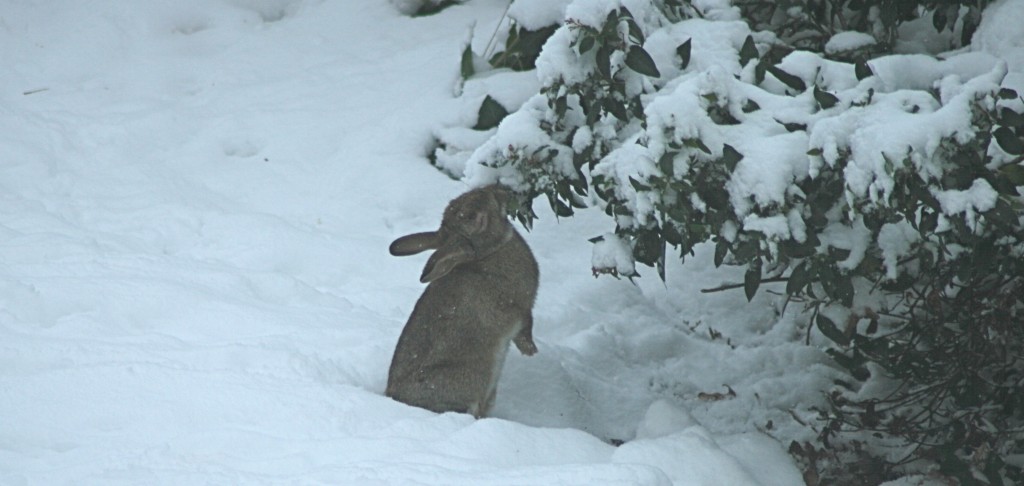
Rabbit in the snow eating branches. (It shows signs of mixy which is why I got close up). c. Celia Haddon
Wild rabbits chew on twigs and branches as well as grazing on grass. Domestic rabbits will spend about five percent of the time gnawing mostly at dawn and dusk (Fernandez-Carmona & Lopez 2006). If they have nothing to gnaw or chew, then rabbits will bite the bars of their cage or chew at their feed bowls (Gunn & Morton 1995, Hansen and Berthelsen 2000). Sixty five out of 102 pet rabbits surveyed had chewed their hutch (Mullan & Main 2006s). House rabbits will chew at skirting boards, furniture, table legs, clothes on the floor, books, electric wires etc. Two thirds of pet rabbits spending time in the house chewed or scratched furniture (Mullan & Main 2006)
So give your rabbit plenty of long-chop hay to chew (Berthelsen & Hansen 1999). You should be feeding this anyway. Straw, as a lining for the hutch, also allows for chewing (Morisse et al., 1999). And also provide things to chew and gnaw. There are lots of good chew toys at www.bunnybazaar.com These will reduce the rabbit’s need to gnaw at your home! Keep your rabbit busy with food dispenser toys, etc. Also, if you can, supply fresh branches from willow or fruit trees (not stone fruit). This will let your rabbit strip the bark, which is what wild rabbits eat in winter.
However, you will still need to bunny proof the surroundings. A block of untreated pine nailed to the skirting board or piece of furniture will reduce damage round the home. Clear plastic Perspex from DIY shops can be installed up to the stretching height of the rabbit. Think about making just one bunny proof room, if you don’t want to do the whole house!
Decorate walls with paint instead of wallpaper. Buy plastic tubing in various diameters or from DIY stores, or flexible cable wraps, to protect the wires or buy trunking to put them through. Rabbits rarely chew plastic tubes, and , if they do, there is time to stop them before they reach the wire. If you have moulded plugs, split the tubes sideways to get the wire in. Use commercial cable tidies to reduce the extent of dangling wire (Dykes & Flack 2003). Relocate your sockets higher up the wall. Transparent carpet coverings are also available from DIY shops. Cover chewed carpet with this. Put clingfilm round the legs of furniture and then cover with cloth to protect against chewing. Site electric plugs high up out of reach.
To stop burrowing behind sofa, buy big cardboard rolls of the kind used to keep carpets on, or large plastic or earthenware tubing from DIY or builders merchants. Or take a wool (not nylon) carpet offcut and tape it into a roll with the carpet inside. Put this behind the sofa so your rabbit can run and hide in it, but the sofa won’t be chewed. Consider shortening your curtains so that your rabbit cannot create the frilled look (Dykes & Flack 2003). Keep houseplants away from rabbits, as some are poisonous.
If you are keeping a house rabbit, try to limit it to a safe area in the house, when you are not around. puppy pens, childrens playpens or compost-heap fencing can be used to make indoor enclosures – but check that it is secure. You may need to add some mesh to make sure your rabbit can’t get its head stuck or squeexe through. If the rabbit is allowed free range then it should be under supervision. Remember rabbits can climb on furniture.
REFERENCES
Berthelsen, H. & Hansen, L. T. (1999), The effect of hay on the behaviour of caged rabbits (Oryctolagus cuniculus),’ Animal Welfare, 8, 149-157
Dykes, L., & Flack, H., (2003), Houserabbit, Dorking, UK, Ringpress
Fernandez-Carmona, J. & Lopez, M., (2006), ‘Behavior of breeding does in cages’, in eds. Maertens, L., & Courdert, P., Advances in Rabbit Sciences, Melle, Belgium, Institute for Agricultural and Fisheries Research, 87-89.
Gunn, D., & Morton, D. B., (1995) Inventory of the behaviour of New Zealand White rabbits in laboratory cages, Applied Animal Behaviour Science, 45, 277-292
Hansen, L. T. & Berthelsen, H., (2000),’ The effect of environmental enrichment on the behaviour of caged rabbits (Oryctolagus cuniculus), Applied Animal Behaviour Science, 68,163–178
Morisse, J.P., Boilletot, E. & Martrenchar, A., (1999), ‘Preference testing in intensively kept meat production rabbits for straw on wire grid floor, ‘ Applied Animal Behaviour Science, 64, 71–80
Mullan, S.M. & Main, D. C. J., (2006), ‘Survey of the husbandry, health and welfare of 102 pet rabbits,’ Veterinary Record, 159, 103-109